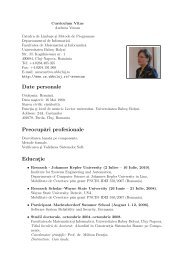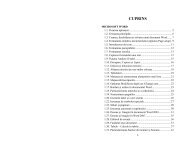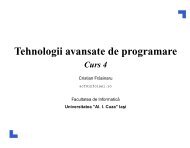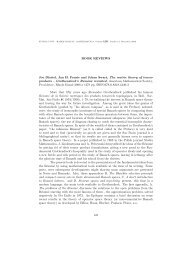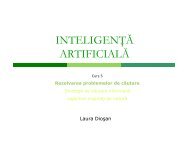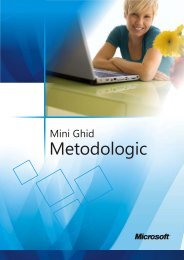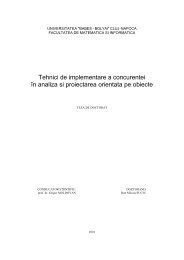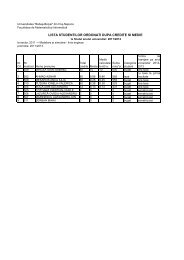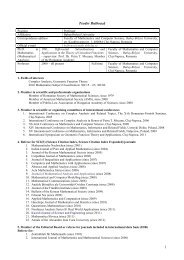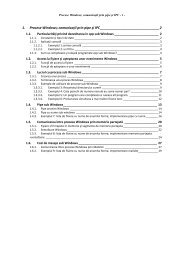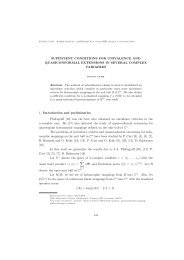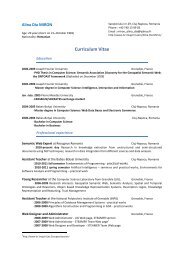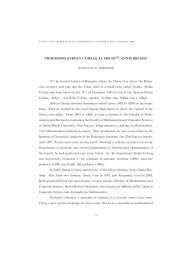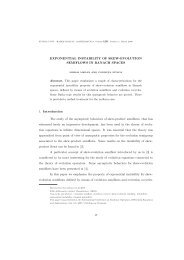CONTENTS
CONTENTS
CONTENTS
You also want an ePaper? Increase the reach of your titles
YUMPU automatically turns print PDFs into web optimized ePapers that Google loves.
220 IOAN ALFRED LETIA (1) AND MIHAI COSTIN (2)<br />
This search is conducted by using the properties of the concepts in the initial domain<br />
as targets, and the properties of the concepts in the array of available ontologies as<br />
search space. The most common, and probably the most efficient, method employed<br />
is the direct string search and this means that the search agent will try to find the<br />
given attributes (as strings or text) in the processed ontologies.<br />
The multiagent system has to extract new concepts from the search space, matching<br />
the initial set and so, expanding it. We are using two different sets, so that we<br />
won’t loose the initial set. The expanded one is employed when processing an ontology<br />
to guide the search. After the current ontology is processed, the expanded set<br />
may be kept for later usage, but the search through the next ontology has to start<br />
from the initial set again. This assures us that the search in one ontology will not be<br />
affected by results from another ontology. However, we can imagine a scenario where<br />
the search should be influenced by previous findings from other ontologies - and that<br />
is, when building a new ontology from an existing array of ontologies with a guiding<br />
set of concepts. But this scenario will probably be taken care of in future works.<br />
The actors of the process are agents, part of a multiagent system, agents that are<br />
specialized for specific tasks - for example we have an agent that will take care of the<br />
”set of concepts into lattice” transformation and an agent that will extract the search<br />
elements from the initial domain. However, we will refer to these specific agents with<br />
the generic name agent.<br />
The initial context is defined by the initial domain - given by an expert in the<br />
field and considered to contain enough information in order to describe the target of<br />
the search - and the array of available ontologies - in our scenario, this resumes to a<br />
couple of ontologies much like the ones we showed the snippets from.<br />
Using this setup, we iterate through the available ontologies and we apply our<br />
search process, process that consists of a few major steps, to be described.<br />
From the initial domain, the agent extracts the search elements that will be used<br />
to guide the search process itself. These search elements consist of properties and<br />
attributes from the concepts in the domain, so basically strings. These strings will<br />
be the target of the search process later on and will guide the agents into finding the<br />
lattice starting points in the search space.<br />
Also from the initial domain, the agent extracts the initial lattice, by considering<br />
the ontology concepts to be the ”formal objects” and their attributes to be the<br />
”formal attributes” of the lattice. This initial, or core lattice, in collaboration with<br />
the extracted lattices from the search space will later on provide the generated lattice<br />
and the generated lattice is our way of determinate the best ontology to use for the<br />
given domain.<br />
As already mentioned, we are using string search in order to find a new concept<br />
or set of concepts that have to be added to our lattice. This part of our process might<br />
require some help from a word thesaurus and we base our affirmation on the fact that<br />
ontologies are mainly composed out of concepts that have a representation as a word<br />
in a certain language. This thesaurus, and it can be something similar to WordNet 1 ,<br />
1 http://wordnet.princeton.edu/



